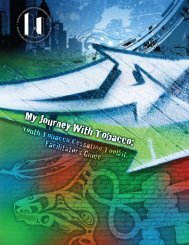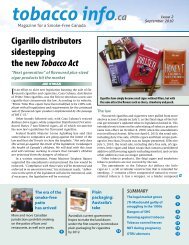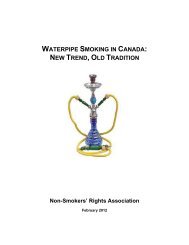Tobacco-Free Sports and Recreation Policies
Tobacco-Free Sports and Recreation Policies - New Brunswick Anti ...
Tobacco-Free Sports and Recreation Policies - New Brunswick Anti ...
You also want an ePaper? Increase the reach of your titles
YUMPU automatically turns print PDFs into web optimized ePapers that Google loves.
<strong>Tobacco</strong>-<strong>Free</strong> <strong>Sports</strong> <strong>and</strong> <strong>Recreation</strong> <strong>Policies</strong><br />
SUMMARY<br />
<strong>Tobacco</strong>-free sports <strong>and</strong> recreation initiatives are relatively new (e.g., Play, Live, Be…<strong>Tobacco</strong>-<br />
<strong>Free</strong> movement). Undertaking these efforts is challenging in local hockey settings where<br />
resources are limited <strong>and</strong> communities rely on volunteers. This evaluation was designed to learn<br />
about the TFSR policies being implemented in Ontario. Levels of awareness, structures <strong>and</strong><br />
processes that are associated with successful policy implementation <strong>and</strong> policy impacts were<br />
explored. Barriers were also identified.<br />
Rationale for TFSR Policy<br />
Each of the four case studies implemented their policy in similar ways, but the impetus for<br />
initiating the TFSR policy differed slightly <strong>and</strong> the time of implementation ranged from 2005 to<br />
2010.<br />
Case Study I (Bantam <strong>and</strong> Peewee teams) emphasized the importance of having the policy in<br />
place to provide role models for the younger players, to raise awareness <strong>and</strong> knowledge about<br />
healthy lifestyles <strong>and</strong> to establish a tobacco-free mindset before these players considered<br />
tobacco use.<br />
Case Study II (Women’s league) also highlighted the importance of healthy lifestyle choices,<br />
positive role modeling as well as prevention, particularly for their own children <strong>and</strong> the girls that<br />
they coach. In addition, several women mentioned that personal health challenges were also a<br />
driver of the relatively recent (2010) TFSR policy implementation in their league.<br />
Case Study III (Junior B) also reported that TFSR policy adoption emerged out of health concerns<br />
(e.g., chew tobacco use) <strong>and</strong> the desire to provide a positive role model for youth, <strong>and</strong> for these<br />
players in turn to set high st<strong>and</strong>ards for non-tobacco use to community members.<br />
Case Study IV (Men’s University) has the longest-st<strong>and</strong>ing TFSR policy, in place since 2005, but<br />
there is no information available on the rationale for adopting the policy.<br />
All four case studies embraced the hope that adoption of the TFSR policy for their team or league<br />
would stimulate change for other hockey teams <strong>and</strong> players. For example, in Case Study I, a PHU<br />
key informant shared that other hockey leagues <strong>and</strong> other sports teams in the community had<br />
become part of a drive to de-normalize the growing issue of chew tobacco use beyond Peewee<br />
<strong>and</strong> Bantam levels.<br />
Ontario <strong>Tobacco</strong> Research Unit 57





